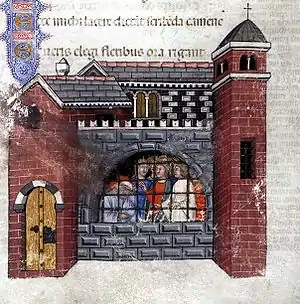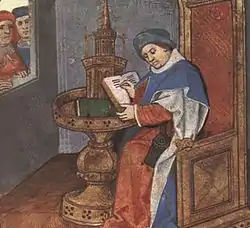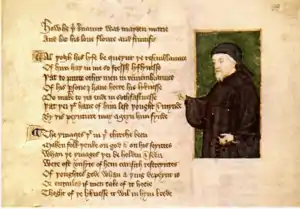Dream vision
A dream vision or visio is a literary device in which a dream or vision is recounted as having revealed knowledge or a truth that is not available to the dreamer or visionary in a normal waking state. While dreams occur frequently throughout the history of literature, visionary literature as a genre began to flourish suddenly, and is especially characteristic in early medieval Europe.[1] In both its ancient and medieval form, the dream vision is often felt to be of divine origin. The genre reemerged in the era of Romanticism, when dreams were regarded as creative gateways to imaginative possibilities beyond rational calculation.[2]

This genre typically follows a structure whereby a narrator recounts his/her experience of falling asleep, dreaming, and waking, with the story often an allegory. The dream, which forms the subject of the poem, is prompted by events in his/her waking life that are referred to early in the poem. The ‘vision’ addresses these waking concerns through the possibilities of the imaginative landscapes offered by the dream-state. In the course of the dream, the narrator, often with the aid of a guide, is offered perspectives that provide potential resolutions to his/her waking concerns. The poem concludes with the narrator waking, determined to record the dream – thus producing the poem. The dream-vision convention was widely used in European, old Russian, medieval Latin, Muslim, Gnostic, Hebrew, and other literatures.
Visions in medieval European literature
In the book "Medieval Latin visions", Russian philologist Boris Yarkho explores the genre of dream visions, defining it in terms of form and content. To the formal aspects of the genre, the researcher refers, first, the didacticism of the genre of visions itself, which should reveal some truths to the reader; secondly, the presence of the image of a "clairvoyant" (or visionary), which has two functions: "he must perceive the content of the vision purely spiritually" and "must associate the content of the vision with sensory images".[3] Third, the formal aspects include psychophysiological phenomena, that is, the situation and circumstances of the vision: lethargy, hallucinations and dreams.
The content of the genre of visions is based on the description of pictures of the afterlife, ghosts and phenomena of otherworldly forces, as well as eschatology. In addition, medieval visions can also be filled with topical content that is adjacent to the "eternal", that is, the afterlife, the otherworldly: socio-political contexts can penetrate into the visions, etc.
Yarkho pays attention to the internal structure of visions, distinguishing two types — "one-vertex" visions and "multi-vertex" (eschatological) visions. The structure of the second type of vision can be "archaic", "classical", or " complexly systematized».[4]
On the Genesis of medieval visions, Rosalia Shor writes in the Literary encyclopedia (1929-1939):
Until the 12th century, all the visions were written in Latin, from the 12th century there are translated ones, and from the 13th — there are original visions in folk languages. The most complete form of visions is represented in the Latin poetry of the clergy: this genre is closely related to canonical and apocryphal religious literature and is close to Church preaching
The peak of the medieval vision genre is considered to be Dante's "Divine Comedy", which can be called a detailed vision, based on its narrative and compositional features.[5]
The deformation of the genre of visions
In the course of evolutionary development, the genre of visions in European literature undergoes natural historical changes: visions are beginning to be used by authors as a means of transmitting satirical content, for writing pamphlets on topical circumstances. As R. O. Shor notes,
since the Tenth century, the form and content of visions have provoked protest, often from the declassified layers of the clergy themselves (poor clerics and goliard schoolboys). All this results in periodic visions. On the other hand, the form of visions is taken over by courtly chivalrous poetry in folk languages: visions here acquire a new content, becoming a frame of love-didactic allegory — such as, for example, "Fabliau dou dieu d'amour" (the Story of the God of love), " Venus la déesse d'amors" (Venus — the goddess of love) and finally-the encyclopedia of courtly love-the famous "Roman de la Rose" of Guillaume de Lorris.[6]
Authors and works
Ancient Roman
- Augustine of Hippo, Soliloquia
- Boethius, De consolatione philosophiae
- Cicero, Dream of Scipio
- Macrobius, Commentary on Cicero's Dream of Scipio
Medieval Latin
- John Gower, Vox Clamantis Book One is an account of the Peasants' Revolt
- Alain de Lille, De planctu naturae
- Brother Marcus, Visio Tnugdali ("The Vision of Tundale")
French
- Guillaume de Lorris and Jean de Meun, Roman de la rose, also translated into Middle English by Geoffrey Chaucer
- Marie de France, The Legend of the Purgatory of St. Patrick
- Le Chemin de Povreté et de Richesse, a 14th-century dream poem incorporated in Le Ménagier de Paris
- Le Chemin de long estude, by Christine de Pizan
Irish
- The aisling is a genre of dream poetry in Irish literature.
Italian
- Dante Alighieri, The Divine Comedy depicts the conventions of dream-vision literature, though Dante specifically says that his vision is not a dream
Old English
- Bede, Vision of Drycthelm
- Anonymous, The Dream of the Rood – the guide in Dream of the Rood is the Cross on which Christ was crucified.
Middle English
- Geoffrey Chaucer, Legend of Good Women, House of Fame, Book of the Duchess, Parliament of Fowls – The Parliament of Fowls features a dream vision in which the narrator falls asleep while reading the Dream of Scipio and is ushered into a walled garden. He is chaperoned in the dream briefly by Scipio the Elder himself.
- William Langland, Piers Plowman or Visio Willelmi de Petro Ploughman (William's Vision of Piers Plowman) is an apocalyptic Middle English allegorical narrative attributed to William Langland, one of the great works of English literature. It is written in unrhymed alliterative verse divided into sections called passus (Latin for "step").
- Sir John Clanvowe, The Cuckoo and the Nightingale
- Anonymous, Parlement of the Thre [sic] Ages
- Anonymous, Wynnere and Wastoure
- Pearl Poet, Pearl
- The Vision of Tundale, a translation from the Latin Visio Tnugdali.
- John Lydgate, The Temple of Glass
Modern English
- John Bunyan, The Pilgrim's Progress
- Percy Bysshe Shelley, The Triumph of Life
- William Morris, News from Nowhere, A Dream of John Ball
- C.S. Lewis, The Great Divorce tells of a dream vision in which the author joins a group of the damned on a vacation bus trip to heaven, where they encounter various figures from their own pasts who try to entreat them to come and join the company of those in heaven.
- The Eagles, "Hotel California"
- Lewis Carroll's "Alice's Adventures in Wonderland" (1865 ) is in the form of a dream vision.
- James Joyce's (Irish novelist) "Finnegans Wake" (1939) consists of an immense cosmic dream.
Welsh
- Anonymous, The Dream of Rhonabwy, possibly a satire on the medieval dream vision
- Anonymous, The Dream of Macsen Wledig
Bibliography
- Boris Yarkho (1989). «Средневековые латинские видения» [Восток-Запад: Исследования, переводы, публикации] (in Russian). Moscow. ISBN 5-02-016791-6.
- Rosalia Shor (1939). Vision. // Literary Encyclopedia (in Russian). Moscow.
References
- Ananya Jahanara Kabir, Paradise, Death and Doomsday in Anglo-Saxon Literature (Cambridge University Press, 2001, 2004), p. 78.
- Christine Kenyon, Jones, "Dreams and Dreaming," in Encyclopedia of the Romantic Era, 1760-1850 (Taylor & Francis, 2004), vol. 1, pp. 293–294; Douglas B. Wilson, The Romantic Dream: Wordsworth and the Poetics of the Unconscious (University of Nebraska Press, 1993), p. 11.
- Ярхо, Борис Исаакович. Из книги «Средневековые латинские видения» // Восток-Запад: Исследования, переводы, публикации. Вып. 4. — М.: Наука, 1989. — ISBN 5-02-016791-6
- Yarkho 1989.
- Shor 1939.
- Rosalia Shor (1939). Vision [Literary Encyclopedia] (in Russian). Moscow. p. 447.


